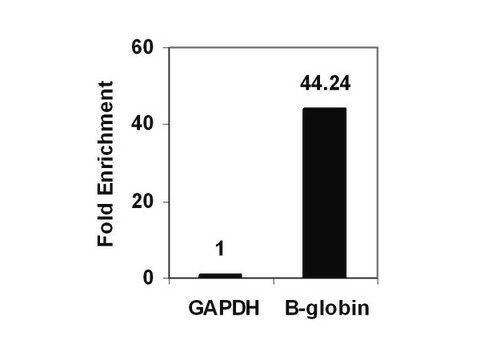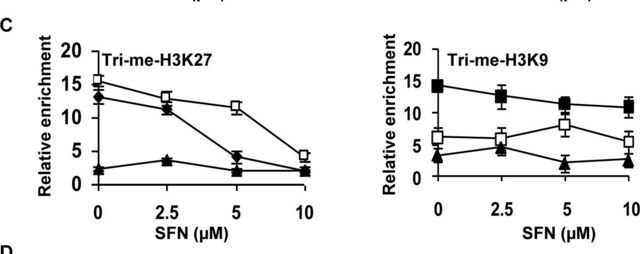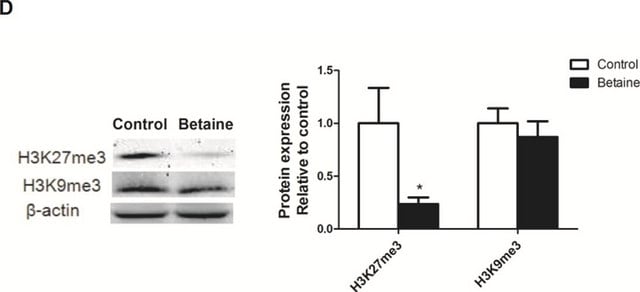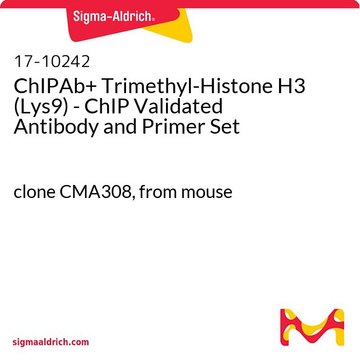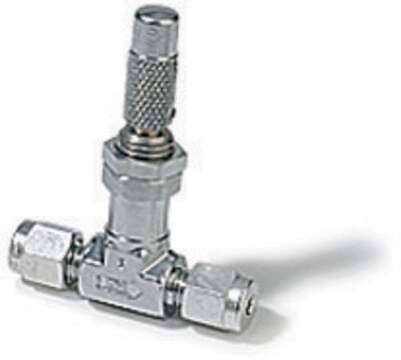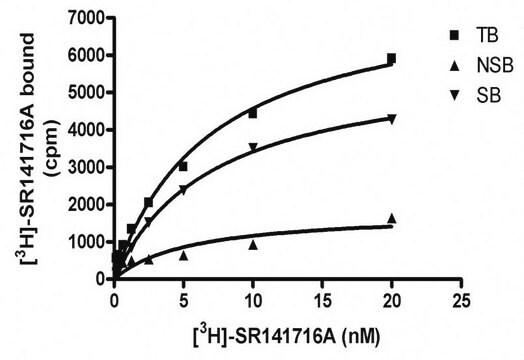17-10108
ChIPAb+ Dimethyl-Histone H3 (Lys27) - ChIP Validated Antibody and Primer Set, rabbit monoclonal
culture supernatant, from rabbit
Sinônimo(s):
H3K27me2, Histone H3 (di methyl K27), H3 histone family, member M, H3 histone, family 2, histone 2, H3c, histone cluster 2, H3c
About This Item
Produtos recomendados
fonte biológica
rabbit
Nível de qualidade
forma do anticorpo
culture supernatant
clone
monoclonal
reatividade de espécies
vertebrates
fabricante/nome comercial
ChIPAb+
Upstate®
técnica(s)
ChIP: suitable
cell based assay: suitable
immunoprecipitation (IP): suitable
western blot: suitable
Isotipo
IgG
nº de adesão NCBI
nº de adesão UniProt
Condições de expedição
dry ice
Categorias relacionadas
Descrição geral
The ChIPAb+ Dimethyl-Histone H3 (Lys27) set includes the Dimethyl-Histone H3 (Lys27) antibody, a negative control rabbit supernatant, and qPCR primers which amplify a 110 bp region of human β-globin promoter. The Dimethyl-Histone H3 (Lys27) and negative controls are supplied in a scalable "per ChIP" reaction size and can be used to functionally validate the precipitation of Dimethyl-Histone H3 (Lys27)-associated chromatin.
Especificidade
Imunogênio
Aplicação
Representative lot data.
Sonicated chromatin prepared from HeLa cells (1 X 10E6 cell equivalents per IP) were subjected to chromatin immunoprecipitation using either 2 µL of Negative Control Supernatant or 2 µL of Anti-dimethyl-Histone H3 (Lys27) and the Magna ChIP® A Kit (Cat. # 17-610).
Successful immunoprecipitation of dimethyl-Histone H3 (Lys27) associated DNA fragments was verified by qPCR using ChIP Primers, human β-globin as a positive locus, and GAPDH promoter primers as a negative locus (Please see figures). Data is presented as percent input of each IP sample relative to input chromatin for each amplicon and ChIP sample as indicated.
Please refer to the EZ-Magna ChIP A (Cat. # 17-408) or EZ-ChIP (Cat. # 17-371) protocol for experimental details.
Western Blot Analysis:
Representative lot data.
A 1:1000-1:5000 dilution of a previous lot detected dimethyl-Histone H3 in acid extracted proteins from HeLa cells, but did not detect unmethylated recombinant Histone H3 (Catalog # 14-494).
Recombinant Histone H3 (lane 1) and HeLa cell acid precipitate (lane 2) were resolved by electrophoresis, transferred to nitrocellulose and probed with anti-dimethyl-Histone H3 (Lys27) (1:1000 dilution).
Proteins were visualized using a goat anti-rabbit secondary antibody conjugated to HRP and a chemiluminescence detection system.
Arrow indicates dimethyl-histone H3 (~17 kDa) (Please see figures).
Peptide Inhibition Assay (PIA):
Representative lot data.
0.5-2 μM of histone H3 peptides containing dimethyl-Lys27 abolished detection of histone H3 by anti-dimethyl-Histone H3 (Lys27) (1:1000 dilution) in immunoblots of acid extracted proteins from HeLa cells.
Acid extracted proteins from HeLa cells were resolved by electrophoresis, transferred to nitrocellulose and probed with anti-dimethyl-Histone H3 (Lys27) (lane 1) or anti-dimethyl-Histone H3 (Lys27) preabsorbed with 0.5 mM of histone H3 peptides containing the following modifications:
Lane 2: dimethyl-lysine 23
Lane 3: dimethyl-lysine 27
Lane 4: dimethyl-lysine 9
A 1:1000 dilution of the primary antibody was used.
Proteins were visualized using a goat anti-rabbit secondary antibody conjugated to HRP and a chemiluminescence detection system.
Arrow indicates dimethyl-histone H3 (~17 kDa) (Please see figures).
Epigenetics & Nuclear Function
Histones
Embalagem
Qualidade
Sonicated chromatin prepared from HeLa cells (1 X 10E6 cell equivalents per IP) were subjected to chromatin immunoprecipitation using either 2 µL of Negative Control Supernatant or 2 µL of Anti-dimethyl-Histone H3 (Lys27) and the Magna ChIP® A Kit (Cat. # 17-610).
Successful immunoprecipitation of dimethyl-Histone H3 (Lys27)-associated DNA fragments was verified by qPCR using ChIP Primers, human β-globin (Please see figures).
Please refer to the EZ-Magna ChIP A (Cat. # 17-408) or EZ-ChIP (Cat. # 17-371) protocol for experimental details.
Descrição-alvo
forma física
Negative Control Supernatant. One vial containing 100 µL of rabbit cultured supernatant in 0.05% sodium azide. Store at -20°C.
ChIP Primers, human β-globin. One vial containing 75 μL of 5 μM of each primer specific for the human β-globin promoter. Store at -20°C.
FOR: AGG ACA GGT ACG GCT GTC ATC
REV: TTT ATG CCC AGC CCT GGC TC
Armazenamento e estabilidade
Handling Recommendations: Upon receipt, and prior to removing the cap, centrifuge the vial and gently mix the solution. Aliquot into microcentrifuge tubes and store at -20°C. Avoid repeated freeze/ thaw cycles, which may damage IgG and affect product performance.
Nota de análise
Includes negative control rabbit supernatant and primers specific for human β-globin promoter.
Informações legais
Exoneração de responsabilidade
Código de classe de armazenamento
10 - Combustible liquids
Certificados de análise (COA)
Busque Certificados de análise (COA) digitando o Número do Lote do produto. Os números de lote e remessa podem ser encontrados no rótulo de um produto após a palavra “Lot” ou “Batch”.
Já possui este produto?
Encontre a documentação dos produtos que você adquiriu recentemente na biblioteca de documentos.
Nossa equipe de cientistas tem experiência em todas as áreas de pesquisa, incluindo Life Sciences, ciência de materiais, síntese química, cromatografia, química analítica e muitas outras.
Entre em contato com a assistência técnica
